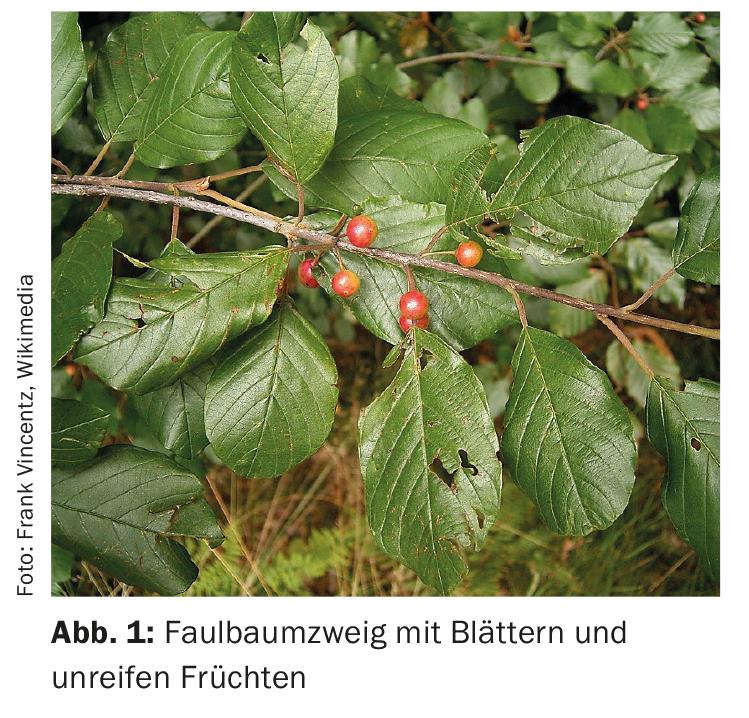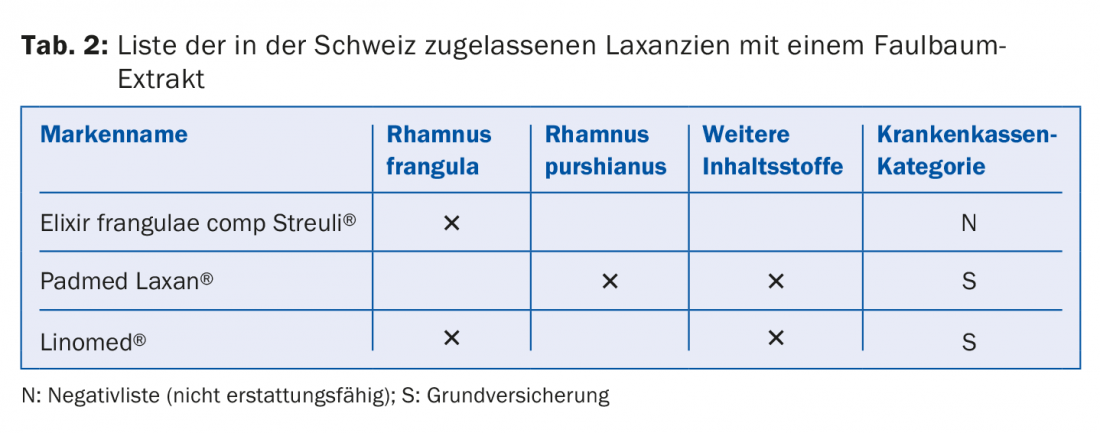A laxative extract consisting of anthraquinone-containing ingredients is obtained from the bark of the rot tree, Rhamnus frangula. However, its effect is weaker than that of the other anthraquinone laxatives. Nevertheless, negative prejudices were widespread for a long time.
A member of the buckthorn family (Rhamnaceae), the black alder tree has two botanical names used synonymously: Rhamnus frangula and Frangula alnus. However, based on the genus name (Rhamnus), Rhamnus frangula is the more common. The German term includes the adjective “faul”. And indeed, the bark of the tree has a slight smell of rot.
Appearance and occurrence
Contrary to its name, the rot tree is not a true tree, but a branched shrub that is usually two to four meters high ( Fig. 1) . Very rarely it grows into a real sapling, but then it can reach a height of up to eight meters. Its range is in subcontinental climates in Europe and extends to western Siberia. It is also common in North Africa (Morocco). Its preferred soils are moist. In addition to Rhamnus frangula, there is also the American sloth tree, Rhamnus purshianus.

Versatile use
The wood of the rotting tree is processed into a high-quality charcoal, which is characterized by a low ash content. That is why in earlier times this charcoal was used to make black powder, the first explosive of firearms.

Ingredients
Tannins and anthranoids, also called anthraquinones, are found in the bark of sloth tree. Anthraquinones are anthracene derivatives, and numerous variants of their basic chemical structure (Fig. 2) exist, some of which are characteristic of anthraquinone-containing plants in which they are found (Table 1).
In alder, these characteristic anthraquinones are glucofrangulin A and B, frangulin A and B, and various frangulaemodine glycosides such as frangulaemodine-8-O-β-D-glucoside. Corresponding anthraquinones, e.g., cascarosides such as cascaroside A, are found in the American alder.

Effect
Anthraquinones have a laxative effect and are therefore used against constipation (box 1). The mechanism of action is based on their antiresorptive effect, i.e. they lead to reduced reabsorption of sodium from the intestinal volume and thus also of water. However, they also have a secretagogue effect by promoting the influx of fluid into the intestine. This causes increasing filling of the colon and soft feces. In the corresponding medicinal plants, anthraquinones are bound to sugars as glycosides. This splits off in the colon, which is why the anthraquinones only act in the colon. Since some of the anthraquinones are excreted in the urine, it may have a dark coloration.
In contrast to other anthraquinone-containing medicinal plants, these active ingredients are predominantly present in oxidized form in alder buckthorn. That is why its effect is somewhat milder than that of other similar medicinal plants.
In contrast, the anthraquinones of the American alder, like the other anthraquinones, have a rather strong effect and not as mild as the glucofrangulins.

Stubborn prejudices
For a long time, anthraquinone-containing laxatives were considered overly effective and even dangerous if used persistently. Corresponding preparations have also been associated by experts with severe side effects such as intestinal irritation and habituation, non-physiological loss of fluids or electrolytes, and sometimes even colon cancer. Accordingly, individuals who requested an anthraquinone-containing laxative from pharmacies (Table 2) were made aware of the presumed dangers for years and thus discouraged from taking it. This approach continued into the new millennium, although a commission of experts had already countered it in 1999: the “Expert Forum on Constipation and Laxatives” had drawn up a consensus paper under the leadership of Prof. Dr. Gerhart Hitzenberger, Vienna. In it, the authors address the dangers of anthraquinone-containing laxatives so often mentioned, writing, “When a laxative is dosed to excrete stool of physiologic, that is, soft, non-liquid consistency, there is no risk of nonphysiologic fluid and electrolyte loss or intestinal damage, even with chronic treatment” [2]. However, although anthraquinone-containing laxatives had thus been rehabilitated by science, the aforementioned prejudices persist to some extent to this day.
Contraindications to anthraquinone laxatives include ileus, inflammatory bowel disease, abdominal pain of unknown cause, and pregnancy and lactation. The drug is not suitable for children under 12 years of age.

Summary
The medicinal plant alder buckthorn, Rhamnus frangula or Frangula alnus, belongs to the anthraquinone-containing medicinal plants, which have a high laxative effect and – contrary to widespread prejudices – also a good tolerance. Within this drug class, the anthraquinones of the alfalfa tree have a rather weaker effect and are very well suited for the treatment of constipation according to the Rome III criteria.
Literature:
- Rome Foundation: Guidelines – Rome III Diagnostic Criteria for Functional Gastro-intestinal Disorders. J Gastrointestin Liver Dis 2006; 15(3): 307-312.
- Hitzenberger G, et al: Expert forum: Obstipation and laxatives, Praxis 1999; 88: 1269-1274.
HAUSARZT PRAXIS 2018; 13(7): 6-8











